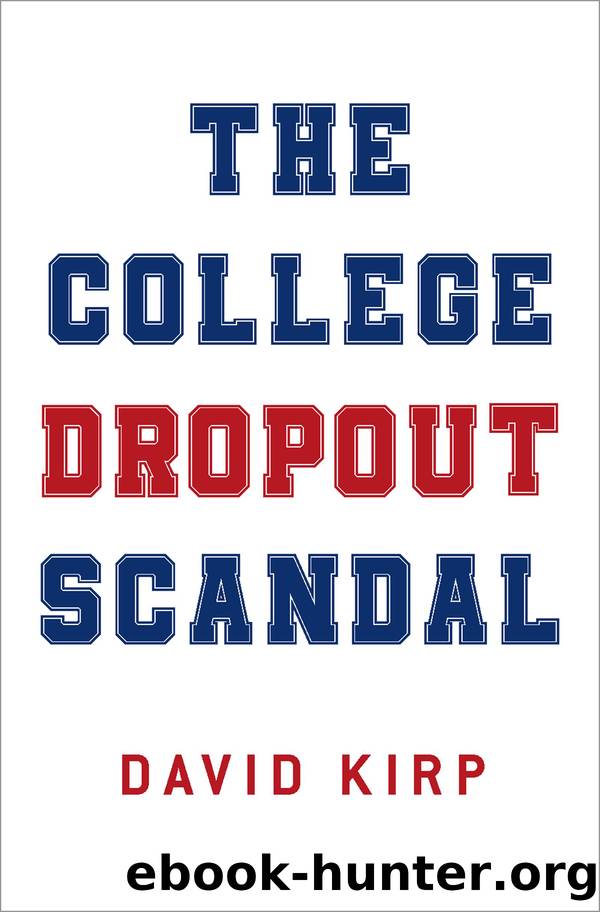The College Dropout Scandal by David Kirp

Author:David Kirp
Language: eng
Format: epub
Publisher: Oxford University Press
Published: 2019-09-15T00:00:00+00:00
Bringing Student Success to Scale
In 2012, David Laude moved into the provostâs office. His assignment was to meet the â70 percent by 2017â goal, which meant expanding the TIP model across the campus.
Today, the TIP-style initiatives that Laude launched serve two thousand freshmen, a quarter of the class, whom the data-mining deems least likely to graduate in four years. A dozen years earlier, when he first offered a bespoke experience to fifty chemistry students, he had to guesstimate whom he should select, but by the time he took on his new assignment the university was using a statistical model that incorporated everything from high school grades and SAT scores to first-gen status to make this calculation. âWe now know that the overwhelming reason students are unlikely to graduate on time is family income. College completion is primarily an economic issue,â says Laude.
To secure campus-wide buy-in, Laude had to convince skeptical, sometimes hostile, professors and administrators to embrace a new way of thinking about undergraduate educationâif the âeveryone deserves an Aâ philosophy of teaching worked in chemistry, there was no reason it shouldnât also work at the business school.
In making his pitch, Laude could count on Bill Powersâs forceful backing. Against the advice of some graybeards, who warned him that curriculum reform was the graveyard of presidents, Powers made revamping undergraduate education his legacy issue. Big-enrollment lecture courses were converted into what are referred to as âflipped classesââstudents come to class having already read the basic material online, prepared for problem-solving activities in the classroom. And every undergraduate had to take a seminar that lifted them out of their disciplinary comfort zone, as well as obliging students habituated to a diet of multiple-choice exams to write essays.
Powers didnât miss an opportunity to underscore the benefits of earning a bachelorâs degree in four years, and this message brought key administrators on board. âWhat I was able to do,â says Laude, âwas to say, âall of us, weâre all going to start working in the same directionâ and they all agreed to it.â
Like everyone else, professors respond to inducements, and the quality of instruction improved when the university introduced financial incentives, including a $7,500 salary boost, for excellence in the classroom. Instead of ridding themselves of students who didnât catch on immediately, more professors strove to help them. In first-year chemistry, the failure rate was halved; in biology, it shrunk by more than two-thirds; and in statistics, it was reduced by three-fourths. The GPA at UT climbed to its highest level in the history of the institution. The courses didnât get easier, the students didnât get brighter, and the faculty didnât embark on a grade-inflation campaign. What changed was the professorsâ attitudes toward their students.
TIPâs multi-pronged approach had proven itself, and in almost every college it serves as the template for the academic success programs. The particulars vary, however, since undergraduates in different fields butt up against distinctive barriers. Laude believed that, in these matters, the colleges, rather the central administration, knew best.
Download
This site does not store any files on its server. We only index and link to content provided by other sites. Please contact the content providers to delete copyright contents if any and email us, we'll remove relevant links or contents immediately.
Special Education in Contemporary Society: An Introduction to Exceptionality by Richard M. Gargiulo & Emily Bouck(325)
Figuring Out Fluency in Mathematics Teaching and Learning, Grades K-8: Moving Beyond Basic Facts and Memorization by Jennifer M. Bay-Williams & John J. Sangiovanni(263)
Clinical trial strategies for rare neurodevelopmental disorders: challenges and opportunities by unknow(214)
Guiding Children's Learning of Mathematics (11th ed) by Leonard M. Kennedy Steve Tipps(170)
Robust High-Yield Methodologies for 2H and 2H15N13C Labeling of Proteins for Structural Investigations Using Neutron Scattering and NMR by Anthony P. Duff & Karyn L. Wilde & Agata Rekas & Vanessa Lake & Peter J. Holden(165)
Daily Routines to Jump-Start Math Class, Elementary School by John J. SanGiovanni;(157)
Supporting Neurodivergent and Autistic People for Their Transition into Adulthood; Blueprints for Education, Training, and Employment by Danny Combs(156)
The Lonely Little Cactus; A Story About Friendship, Coping and Belonging by Kelly-Ann Allen & Madeleine Griffith(149)
Accessing the General Curriculum by Nolet Victor;McLaughlin Margaret J.;(148)
Multimedia in Education and Special Education by Onan Demir; Cari Celik(135)
Begin with the Brain by Kaufeldt Martha M.;(132)
Reshaping Engineering Education by Fawwaz Habbal & Anette Kolmos & Roger G. Hadgraft & Jette Egelund Holgaard & Kamar Reda(132)
Feedback in Online Course for Non-Native English-Speaking Students by Larisa Olesova(130)
Raising Self-Esteem in Primary Schools : A Whole School Training Programme by Margaret Collins(128)
Bullying Beyond the Schoolyard by Sameer Hinduja & Justin W. Patchin(118)
Conquering Third Grade by Kristy Stark(118)
Negotiating Political Identities by Daniel Faas(115)
Understanding Supervision and the PhD by Moira Peelo(114)
Removing College Price Barriers : What Government Has Done and Why It Hasn't Worked by Michael Mumper(112)
